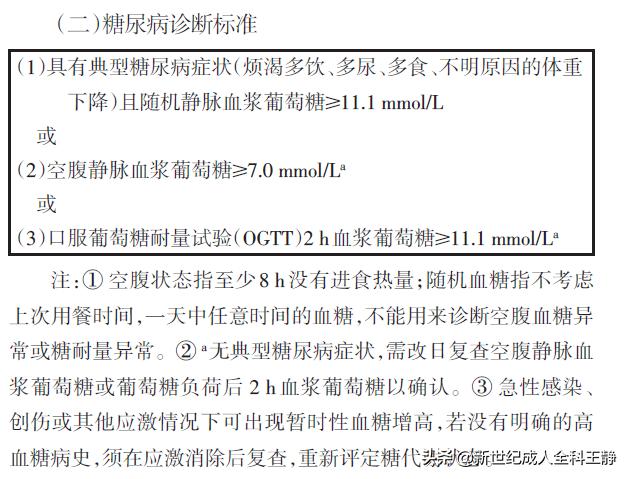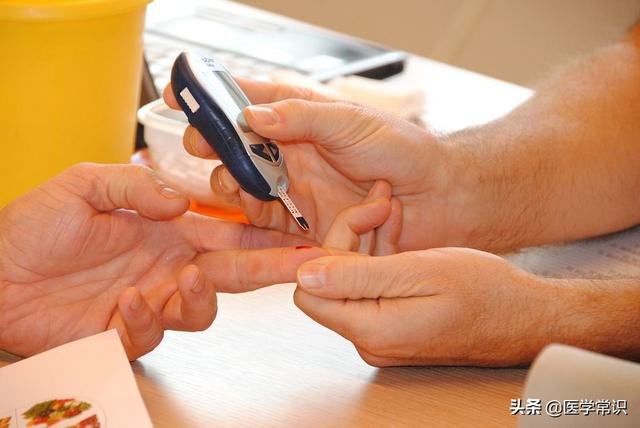What constitutes diabetes?
Diabetes is a common disease of modern life and everyone needs to prevent it from occurring because some unhealthy habits can lead to diabetes:
1, balanced diet, light diet, limit energy intake, reduce high oil, high sugar and high salt diet, and choose more vegetables and fruits, vegetables and fruits are rich in dietary fiber, which helps to prevent diabetes.
2, modern people are sedentary for a long time, sedentary will affect the life expectancy, but also make the risk of diabetes increased. For people with sedentary lifestyle, it is best to sit for half an hour to get up and move around, such as getting up to get a glass of water, going to the toilet, and so on.
3, modern people due to work, life rhythm accelerated, mental stress, easy to lead to diabetic patients. The human body is in a state of long-term stress, sympathetic nerve excitation, will prompt an increase in the secretion of blood sugar-raising hormones, such as adrenaline, catecholamines, etc.; in addition, sympathetic nerve excitation, will directly inhibit the secretion of insulin, resulting in elevated blood sugar. To prevent diabetes, learn to relax and do not give yourself too much pressure.
4, reduce the late night, the human body in the late night, the body is also in a state of stress, easy to lead to elevated blood glucose, over time, will increase the burden on the pancreas, easy to occur diabetes.
5, quit smoking and limit alcohol, tobacco will directly stimulate the pancreas, so that the pancreas function is impaired, easily lead to insufficient insulin secretion, thus occurring diabetes. Alcohol's energy value is high, often a large number of drinking will lead to obesity, obesity will cause insulin resistance, thus appearing high blood sugar.
6, obese people should actively lose weight, obesity is one of the important causes of diabetes, so obese people are at high risk of diabetes, obese people can limit their diet, strengthen physical activity and other ways to reduce weight.
There are about 114 million people with diabetes in China, accounting for about 27% of the global diabetes population, and it has become the country with the largest number of diabetes patients in the world.
Many diabetic patients do not have clinical symptoms, and some are diagnosed by physical examination or other tests by chance; others are only discovered when they have diabetic complications and are sent to the hospital for emergency treatment. A year ago, a friend of mine had a child who had ketoacidosis and was admitted to the ICU with poor consciousness before it was discovered that the child had diabetes.
If we want to talk about the typical symptoms of diabetes mellitus, it is the well-known "three more and one less", more food, more drink, more urination, and weight loss. A colleague of mine discovered diabetes because of excessive urination.
In addition to clearly diagnosed diabetes, there is a large proportion of people who are in the pre-diabetic stage, which we call "pre-glycemic", and this large group of people, like the tip of an iceberg, is a staggeringly large and under-appreciated number!

Image from the web
As mentioned above.A large number of people with diabetes are asymptomatic, and the typical three more or less symptoms are not that common. In addition to clinical symptoms, it is up to laboratory indicators to confirm a diagnosis of diabetes.


In terms of blood glucose monitoring levels, to confirm a diagnosis of diabetes, two points in time are needed, afasting blood sugarOne isPostprandial or 2 hours after OGTT testThe blood sugar level. In our country, can diabetes is generally required to do OGTT test, in foreign countries, there is another indicator can diagnose diabetes, is glycated hemoglobin, if the indicator is more than 6.5%, basically can confirm the diagnosis of diabetes.
What is the OGTT test? The test can be understood as a test to confirm the diagnosis of diabetes and is done as follows:
1. Starting at 7:00-9:00 a.m., subjects were given 75 g of anhydrous dextrose powder dissolved in 300 ml of water or 82.5 g of 1-molecule dextrose in water, or 1.75 g of dextrose in water per kilogram of body weight for children, not exceeding a total of 75 g. Sugar water was consumed within 5 min.
2. Starting from the first mouthful of sugar, blood was collected from the forearm before and 2 h after sugar intake to measure blood glucose.
3. During the course of the test, the subject does not drink tea and coffee, does not smoke, does not do strenuous exercise, but does not need to be absolutely bedridden.
4. Blood specimens should be sent for testing as early as possible.
5. Carbohydrate intake of not less than 150 g per day during the first 3 d of the trial.
6. Discontinue drugs that may affect OGTT such as contraceptives, diuretics or phenytoin sodium for 3-7 d before the test.

Image from the web
A simple way to understand this test is to drink a glass of sugar water and have your blood drawn at regular intervals for blood sugar testing.
Pregnant mothers in obstetrics will also have this test done in the middle of their pregnancy to clarify if there are any abnormalities in blood sugar metabolism. This is because blood sugar abnormalities in pregnant mothers can affect the growth and development of the fetus.
In short, in a word, want to early screening for diabetes, in addition to pay attention to their own body has no symptoms, is to pay attention to physical examination. However, there is a problem with physical examination, that is, generally measure fasting blood sugar, but in fact, China's diabetes and pre-diabetes, a large portion of the population fasting normal, postprandial blood sugar is high, easy to cause missed diagnosis. Therefore, during the physical examination, you can check the two indicators of fasting blood glucose and glycated hemoglobin together, so that you can find as many abnormalities as possible.
Image from the web
References:
Chinese Medical Association Diabetes Branch National Office of Primary Diabetes Control and Management National Guidelines for Primary Diabetes Control and Management (2018). Chinese Journal of Internal Medicine, 2018, 57(12): 885-892.
Diabetes mellitus is a common and frequent disease, and its prevalence increases rapidly with the improvement of people's living standards, the aging of the population, and changes in lifestyle. It is mainly characterized by various symptoms and complications caused by metabolic disorders.
Having diabetes will make it easy to spot clues or symptoms:
1. Three more and one less symptom. That is, drinking more, eating more, urinating more, and unexplainable weight loss.
2. Discover the complications or concomitant diseases of diabetes. For example, unexplained acidosis, water loss, coma, shock, dyslipidemia, hypertension, nephropathy, retinopathy, peripheral neuritis, gangrene of the lower limbs and metabolic syndrome, as well as recurring itching, ulcers or carbuncles of the skin, and fungal vaginitis and vulvar itching in women.
3. Auxiliary examination. It can be taken as intravenous plasma glucose test, or peripheral blood test or simple blood glucose test. The main tests are fasting blood sugar, random blood sugar and 2 hours postprandial blood sugar, if the measured blood sugar value is higher than normal, and there are the above symptoms, the diagnosis can be made, in the clinic, need to be repeated every other day to confirm that the diagnosis can be established.

4. For those who have no symptoms of diabetes and whose blood glucose value reaches the diagnostic criteria for diabetes on only one occasion, the diagnosis must be confirmed by review and verification on another day. If the results of the review do not meet the diagnostic criteria for diabetes mellitus, they should be reviewed periodically.
5, there is a family history of diabetes or a family history of obesity, and the age of more than 45 years old, obese people, such as the emergence of any one of the symptoms, should be early to seek medical attention, to identify in the end is not diabetes.
In conclusion, most diabetic patients, especially those in the early stage of diabetes, do not have obvious symptoms. Therefore, we need to learn more about diabetes, be good at detecting diabetes in our work and life, and achieve early diagnosis and treatment as much as possible.

I hope the above answer is helpful to you, please criticize and correct in the comment section! Follow Common Sense Medicine to learn more about your health!
Diabetes has become increasingly popular and is a serious threat to human health. In life, the causes of diabetes are complex and varied, the more common are obesity, dietary intemperance, lack of exercise their other diseases. Specifically as follows:

1. Viral infection factors
Viruses can also cause diabetes. This is because people with diabetes often have had a viral infection some time before the onset of the disease, and epidemics of diabetes often follow viral epidemics.
2. Immune factors
Diabetes mellitus is an autoimmune disease characterized by immune islet inflammation and selective islet β-cell damage mediated by T lymphocytes, and about 67-88 % of newly diagnosed children with type 1 diabetes mellitus have islet inflammation of the pancreas, with significant infiltration of T and B lymphocytes.
3. Environmental factors
Environmental factors include viral infections, milk feeding during infancy, vaccinations, geography, climate, toxins, and stress, all of which contribute to the development of diabetes.
4. Genetic factors
Research suggests that genetic defects underlie the development of diabetes, and that genetic defects are manifested in abnormalities of the hla antigen on the sixth pair of human chromosomes. Sina Chinese medicine research shows: diabetes patients have the characteristics of familial development, if your parents have diabetes, then compared with people without this family history, you are more prone to develop this disease.
5. Pregnancy
The increase of orange anti-insulin hormones such as growth hormone, prolactin, estrogen, adrenocorticotropic hormone secretion, and progesterone during pregnancy, in addition, the placenta can produce insulinase, which accelerates the degradation of insulin.
6. Long-term mental stress
The high pace of life in modern society, excessive study and work will cause people to produce tension, long-term in a state of mental tension and high pressure, will make diabetes aggravated.
There are 4 key points to preventing diabetes
Ignorance of diabetes: know a little more experts pointed out that many people think that drinking more, eating more, urinating more, wasting is the manifestation of diabetes, and this to determine whether they have diabetes, in fact, not. To "three more and one less" symptoms to determine whether there is diabetes is a typical misunderstanding of diabetes. In fact, 90% of diabetic patients lack these symptoms in the early stage, and only show fatigue, fatigue, or atypical symptoms such as blurred vision and wounds that do not heal. Because diabetes does not show obvious physical abnormalities at the early stage of its development, and when the "three more and one less" symptoms appear, its condition is already quite serious. Therefore, whether young or old, at least once a year should go to the regular hospital for blood glucose testing, which is currently the most accurate way to determine diabetes. Daily listening to diabetes knowledge lectures can benefit, lectures are conducive to help patients adhere to scientific treatment, there are many false advertisements on the market, saying that a certain drug can cure diabetes, a certain instrument can not take drugs and cure diabetes. Knowledge lectures can enable patients to objectively recognize the health care products on the market, rational use of medication, blood sugar control.
Excessive calorie intake: Eat less Traditionally, for diabetics, rice should not be eaten to the fullest, fruit should not be eaten too much, and desserts should basically not be touched. Should not eat all kinds of sugar, candied fruit, canned fruit, soda, fruit juice, jam, ice cream, sweet cookies, sweet bread and sugar pastries, etc., because these foods are very high in sugar, easy to consume high blood sugar; should not eat high cholesterol-containing foods and animal fats, such as animal brains, livers, hearts, lungs, waists, yolks, fat, butter, pigs, cows and sheep oil, etc., which can easily make the blood fat rise, prone to atherosclerosis; Adhere to a daily cup of tea that can help regulate blood sugar: (click on the big picture to understand)

Reduced physical activity: Be more active and maintain a certain amount of exercise on a regular basis. Diet control, coupled with enhanced exercise, the weight is not too fat. We already know that obesity is an important factor in causing diabetes, not obese, the chance of getting diabetes will be reduced. There is a British proverb that says, "The longer the belt the shorter the life span," so it is important to control your weight. Relax. This refers to the mental conditioning aspect. A good state of mind also has its positive effect on the prevention of diabetes. This is because various psychological imbalances can further strengthen insulin resistance and contribute to the development of diabetes. There is such a situation, perhaps you originally will be a few more years before diabetes, just because of a big mental stimulation, a very long time worried about the frown, may soon get diabetes.
Increased psychological stress: Relax a little Although patients use balanced diets, exercise and medication to maintain blood glucose levels at a certain level, mental stress can indirectly increase blood glucose. Therefore, in order for blood sugar to return to normal levels, in addition to diet, exercise, and medication control, patients need to keep in mind the importance of eliminating mental stress and maintaining emotional well-being. The latest science confirms that when people are in tension, anxiety, fear or shock and other emotions, sympathetic nerve excitation, direct inhibition of insulin secretion; sympathetic nerve will also accelerate the speed of adrenaline secretion, indirectly inhibit insulin secretion. Researchers remind people that relaxation can indirectly increase insulin secretion, for the control of diabetic patients have the benefit of the disease.
Hello, I'm Health Manager Con, and I'm happy to answer your questions.
In the beginning, diabetes appeared in the family of the rich and powerful, so it was called the "disease of the rich and powerful", but later on, people gradually realized that even people who were not rich and powerful could suffer from diabetes. So, how do you develop diabetes? Let's discuss it together.

First, what is diabetes?
Diabetes mellitus is a common endocrine metabolic disease, which is a cluster of metabolic disorders characterized by elevated plasma glucose levels. The pathophysiologic mechanism causing elevated blood glucose is defective insulin secretion or defective insulin action.
Next, let's find out what are the risk factors for diabetes?
1 Genetic factors A family history of diabetes is associated with a greater than normal chance of developing diabetes.
2 Overweight and Obesity Diabetes occurs as a result of a smaller density of insulin receptors on the membranes of adipocytes, as well as reduced sensitivity to insulin.
3 Lack of Exercise Regular moderate exercise helps the body to consume sugar.
4 Unreasonable diet The increase in high-fat and high-calorie components in the diet directly contributes to the excessive accumulation of body fat, which has become a major trigger for the rise in the incidence of diabetes mellitus.
5 Mental tension Due to long-term high mental tension, resulting in excessive adrenaline secretion, which causes a sustained increase in blood glucose and blood pressure.
6 Smoking The mechanism by which smoking triggers diabetes may be related to the toxic effects on pancreatic islet 13 cells by altering the distribution of fat in the body.
7 Diabetes occurs as a result of long-term exposure to chemical and radioactive substances, which destroys the function of pancreatic islet cells.
8 Repeated viral infections Viral infections damage the islet B cells and diabetes occurs.
Through the above analysis, we can understand that the causes of diabetes, except for heredity, other risk factors can be changed by us. It can also be said that diabetes is largely determined by our lifestyle behaviors. The prevention of diabetes starts from increasing the awareness of self-care.
Sugar man health network, a temperature control of sugar platform, welcome to pay attention to the questions and answers!
The safest thing to do, just go to the hospital and get checked out.
There are more ways to lower blood sugar, and your doctor will advise you on whether to take diet, medication, or insulin, depending on the patient's different levels of blood sugar.
Point 1 is the presence of three more or less symptoms of diabetes mellitus accompanied by plasma glucose greater than or equal to 11.1 mmol per liter. Number 2 is two fasting plasma glucose greater than or equal to 7.0 millimoles per liter. Point 3 is two randomized plasma glucose greater than or equal to 11.1 millimoles per liter. Point 4 is two OGTT experiments with two-hour plasma glucose greater than or equal to 11.1 millimoles per liter. No. 5 is one fasting plasma glucose greater than or equal to 7.0 mmol/L, and one randomized or one OGTT two-hour plasma glucose greater than or equal to 11.1 mmol/L. A diagnosis of diabetes can be made when one of these five points is met.
How do I know I have diabetes? Do I have to take hypoglycemic medication all year round after being diagnosed with diabetes?
1. First of all, how to diagnose diabetes?
Typical symptoms of diabetes mellitus: three more and one less: drinking more, eating more, urinating more and losing weight. In addition, there are also metabolic disorders such as itchy skin and blurred vision.
The above diabetes symptoms + venous blood glucose measurement, Note: The best way to confirm the diagnosis is to go to the hospital and have venous blood drawn. (Fasting plasma glucose ≥ 7.0 mmol/l, 2h post glucose load blood glucose test ≥ 11.1 mmol/l, random blood glucose test ≥ 11.1 mmol/l) is diagnostic.
2. Do you take hypoglycemic medication year-round after being diagnosed with diabetes?
This is because diabetes is a chronic systemic progressive endocrine metabolic disease. Since it is a chronic disease, it does require long-term, even lifelong, medication after diagnosis. Why? This starts with the pathogenesis of diabetes. Simply put, diabetes is categorized into type 1 diabetes and type 2 diabetes.
Type 1 diabetes is usually congenital presence of immune system abnormalities and defective pancreatic secretion in the body leading to insufficient insulin secretion, so direct insulin injections are required.
Type 2 diabetes mellitus is acquired: obesity, hypertension, and hyperlipidemia due to overeating and reduced physical activity are the main causative factors.
To summarize: type 1 diabetes is a defect in pancreatic islet secretion and definitely requires lifelong insulin injections, which can cause absolute insulin deficiency in the body once treatment is stopped.
Type 2 diabetes because it is acquired, the pancreas itself can still secrete insulin, but the secretion is relatively insufficient, need to actively change the lifestyle, control the mouth, take a step, lowering blood pressure, lowering blood lipids, lowering body weight at the same time you can first oral hypoglycemic drugs, according to the situation of the blood glucose control can be appropriate to increase or decrease the drug, but can not be suddenly stopped.
The above is a personal opinion, welcome to follow the discussion.

Acknowledgments! The central theme of this question deals primarily with the diagnosis of diabetes.
Diabetes mellitus is the most common metabolic disorder in clinical practice, and is an independent risk factor for coronary and peripheral atherosclerosis, which is categorized into type 1 and type 2, with type 1 diabetes accounting for about 10% of the total number of diabetes mellitus, and type 2 accounting for up to 90% of the total number of diabetes mellitus!
Clinical manifestations of patients with each type:
1型:: First symptoms are often precipitated by infection or other stress; weight loss; excessive urination, drinking, and eating; dehydration; fatigue; frequent infections (e.g., urinary tract infections, cellulitis, etc.); high blood pressure; blurred vision; abnormal mental status; and sweet-fruity odor on expiration.
Fasting blood glucose is a common clinical test that usually needs to be repeated every other day for reconfirmation! Fasting blood glucose over 126 mg/dl can be considered diabetic.
Oral medication is not effective in this type of diabetes and often requires a strict diabetic diet, with exercise and insulin therapy being the key. Daily blood glucose monitoring before meals and at bedtime is required.
Type 2.Previously, it was common among the elderly and the obese, but with the continuous improvement of living standards, the sharp increase in the number of small chubby people and the decrease in the amount of exercise, in recent years, it has been found that more and more adolescents and children are suffering from the disease.
It usually manifests itself in the form ofThe onset of the disease is insidious and not easy to detect, may be years or even decades before the diagnosis of diabetes; polyuria, polydipsia, polyphagia; fatigue, blurred vision; recurrent infections; if the long-term poor glycemic control can be other organ pathologies: retinopathy such as cataracts, nephropathy, arteriosclerosis such as foot ulcers gangrenous, autonomic and peripheral neuropathies, and so on.
The test relies on a fasting blood glucose test!
The basic treatment is the "triple axe" of diet, exercise and weight control!
Diabetes mellitus is a heterogeneous group of metabolic disorders characterized by prolonged hyperglycemia with impaired metabolism of carbohydrates, fats, and proteins, caused by a defect in insulin secretion and/or a decrease in insulin sensitivity of target tissues due to the interaction of genetic and environmental factors. Diabetes mellitus may manifest typical symptoms such as thirst, polyuria, polydipsia, weight loss, and polyphagia. Long-term elevated blood glucose can lead to chronic damage, dysfunction, and failure of many organs, including the eyes, kidneys, heart, and blood vessels. The diagnosis of diabetes mellitus is based on the 1999 World Health Organization's diagnostic criteria for diabetes mellitus: 1. diabetes mellitus symptoms and blood glucose level greater than or equal to 11.1 mmol/L at any time; 2. fasting plasma glucose greater than or equal to 7.0 mmol/L; 3. standard glucose tolerance test, venous plasma glucose 2 hours after meal greater than or equal to 11.1 mmol/L. Any single one of the above three criteria can be regarded as diabetes mellitus. If any one of the above criteria is met, it can be used as the basis for the diagnosis of diabetes mellitus. If necessary, the test should be repeated on another day using the above method, and if the result still meets the criteria, diabetes mellitus can be diagnosed definitively.
This question and answer are from the site users, does not represent the position of the site, such as infringement, please contact the administrator to delete.